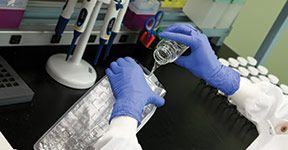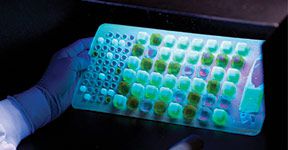Water samples from the pond are obtained by PPGA during the summer months, primarily from the east and west community beaches. These samples are brought to a laboratory and tested for bacterial contamination.
So what tests are run on these samples? Ideally, we would want to know exactly what disease-causing organisms are present in the water, so we could figure out exactly what level is safe and unsafe for swimming. Unfortunately, this level of testing would be extremely expensive and time-consuming. So, "screening" tests are conducted instead to determine the level of two broad classes of organisms: Total Coliform bacteria and E. Coli bacteria. These analyses are relatively easy, fast, and inexpensive ($25 a sample), and measure the amount of these bacteria in a sample in units of "colonies" or "organisms" per 100-mL of water.
Coliform bacteria are almost always present in lake water and come from many "natural" sources , and do not necessarily indicate a problem with water quality. On the other hand, E. Coli (short for Escherichia Coli) is a type of Coliform bacteria that is present in the feces of warm-blooded animals, including geese, dogs, and people. Their presence means there may be some amount of fecal contamination in the water, and that fecal matter may contain disease-causing organisms (known as "pathogens").
So, to be safe, government agencies have established limits on the levels of E. Coli bacteria in swimming areas. Levels below those limits should be safe for all swimmers - including young children. Levels above those limits may or may not be safe (depending on the exact types and quantities of pathogens that may or may not be present).
It's important to understand that the level of E. Coli in the lake can vary quite a bit. For example, levels often rise after a rain event, as animal feces from streets and land areas are washed into the pond. Or there could be a "spike" if a sample is obtained in an area where a flock of geese had recently relieved themselves. For that reason, government regulations usually set two limits for E. Coli: a one-time "not-to-exceed" level, and an "average" level over time.
OK - so what are these limits for E. Coli? Depends where you live. In Massachusetts, for fresh water beaches, the single "not to exceed" limit for E. Coli is 235 colonies per 100-mL, and the "geometric mean" of the last 5 samples should not exceed 126 colonies per 100-mL. (New Hampshire has stricter limits: a not-to-exceed standard of 88 and 3-sample geometric mean of 47; some states, including Michigan, are a little less strict than Massachusetts)
What can happen to you if you swim in water with excessive E. Coli levels? You can become sick - but, fortunately, most of these illnesses are not usually very serious or long-lasting. The most common impacts include stomach cramps, low-grade fever, diarrhea, vomiting, and ear/nose or throat infections. Long time lake residents can not recall any complaints of this nature that were likely due to swimming in polluted water.
E-Coli Testing in Peters Pond








PPGA is the ONLY entity testing the water at peters pond - not the town, not the state. Consider joining or donating to PPGA to help us cover the cost of this testing.
Water Testing
E. Coli Levels in Peters Pond
E. Coli levels in Peters Pond are generally low, though there have been occassional spikes. When a spike is noted, samples are immediately re-taken, to determine if levels remain elevated. If they remain above 235 colonies per 100-mL, a sign will be posted at the commumity beach informing residents of this condition.
While most samples are obtained from the community beaches, limited testing in the middle and north end of the pond have shown very low levels of E. Coli (less than 5 colonies per 100-mL), which is good news for those who swim or tube in these areas.
Click on the "Bacteria" drop down menu in the Water Testing tab to see graphs and tables of E. Coli testing results, and to download the laboratory testing report sheets.
E.Coli is the most frequent test run on pond water. That's because it can change from day to day, and unlike weeds, this contaminant is not something you can usually see or smell (unless it is really bad).
Other test that can and have been conducted on the pond by PPGA and others inlcude the following:
GENERAL WATER QUALITY PARAMETERS
This includes pH, alkalinity, nitrogen, phosphorus, specific conductance, dissolved oxygen, and temperature. These parameters speak to the general health of the lake, and can have a big impact on fish populations, and on weed and algae growth.
CYANOBACTERIA ("Blue Green Algae")
Many people have heard of blooms of "Blue Green Algae"; most notably in Long Pond in Dracut/ Tyngsboro/Pelham. This can be very noticeable, with these blooms often turning the water a bright green color. The good news: there have been no known outbreaks in Peters Pond in at least the last 30 years. But that doesn't mean it can't happen, and PPGA has and is taking steps to periodically screen water samples for evidence of this condition.
Click on the "Other Testing" drop down menu in the Water Testing tab to see more details of and results from these additional testing programs.